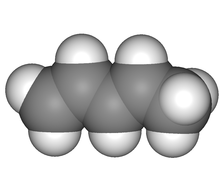
| |

| |
| Names | |
|---|---|
| Preferred IUPAC name (3E)-Penta-1,3-diene | |
| Identifiers | |
| CAS Number | |
| 3D model (JSmol) | |
| ChEBI | |
| ChemSpider | |
| ECHA InfoCard | 100.007.269 |
| EC Number |
|
| PubChem CID | |
| RTECS number |
|
| UNII | |
| UN number | 1993 3295 1010 |
| CompTox Dashboard (EPA) | |
InChI
| |
SMILES
| |
| Properties | |
| Chemical formula | C5H8 |
| Molar mass | 68.117 g/mol |
| Appearance | Colorless liquid |
| Density | 0.683 g/cm |
| Melting point | −87 °C (−125 °F; 186 K) E-isomer |
| Boiling point | 42 °C (108 °F; 315 K) E-isomer |
| Hazards | |
| GHS labelling: | |
| Pictograms |   
|
| Signal word | Danger |
| Hazard statements | H225, H304, H315, H319, H335 |
| Precautionary statements | P210, P233, P240, P241, P242, P243, P261, P264, P271, P280, P301+P310, P302+P352, P303+P361+P353, P304+P340, P305+P351+P338, P312, P321, P331, P332+P313, P337+P313, P362, P370+P378, P403+P233, P403+P235, P405, P501 |
| Flash point | < −30 °C (−22 °F; 243 K) |
| Except where otherwise noted, data are given for materials in their standard state (at 25 °C , 100 kPa).
| |
Piperylene or 1,3-pentadiene is an organic compound with the formula CH3−CH=CH−CH=CH2. It is a volatile, flammable hydrocarbon. It is one of the five positional isomers of pentadiene.
Reactions and occurrence
Piperylene is a typical diene. It forms a sulfolene upon treatment with sulfur dioxide.
Piperylene is the product of the decarboxylation of sorbic acid, a common anti-mold agent.
Piperylene is obtained as a byproduct of ethylene production from crude oil, combustion of biomass, waste incineration and exhaust gases. It is used as a monomer in the manufacturing of plastics, adhesives and resins.
See also
References
- Safety (MSDS) data for piperylene. Retrieved 2007-11-14.
- Robert L. Frank, Raymond P. Seven (1949). "Isoprene Cyclic Sulfone". Organic Syntheses. 29: 59. doi:10.15227/orgsyn.029.0059.
- Erich Lück, Martin Jager, Nico Raczek (2000). "Sorbic Acid". Ullmann's Encyclopedia of Industrial Chemistry. Weinheim: Wiley-VCH. doi:10.1002/14356007.a24_507. ISBN 3527306730.
{{cite encyclopedia}}: CS1 maint: multiple names: authors list (link) - Piperylene Archived 2009-05-13 at the Wayback Machine at Shell Chemicals. Retrieved 2009-05-19.
This article about a hydrocarbon is a stub. You can help Misplaced Pages by expanding it. |
| Hydrocarbons | |||||||||||||||||||||||||||||||||||
|---|---|---|---|---|---|---|---|---|---|---|---|---|---|---|---|---|---|---|---|---|---|---|---|---|---|---|---|---|---|---|---|---|---|---|---|
| Saturated aliphatic hydrocarbons |
| ||||||||||||||||||||||||||||||||||
| Unsaturated aliphatic hydrocarbons |
| ||||||||||||||||||||||||||||||||||
| Aromatic hydrocarbons |
| ||||||||||||||||||||||||||||||||||
| Other | |||||||||||||||||||||||||||||||||||